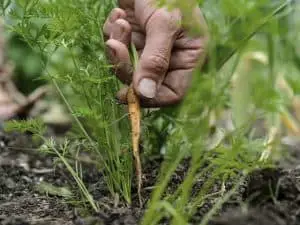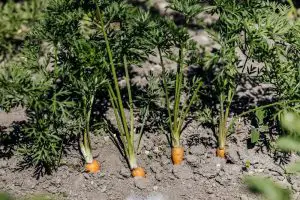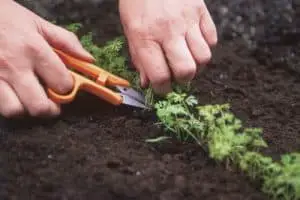Contents
Carrots are one of those plants that grow amply and are liked around the world. But, to ensure a good quality harvest, you need to check the detrimental factors for its growth. The carrot plants grow densely, and hence farmers and cultivators practice what is called “thinning carrots.” During this process, weak and small seedlings are removed to allow large and strong seedlings to grow up. If you are someone who is learning how to grow carrots in a spaced manner, then read on to know more!
What Exactly Is “Thinning Carrots”?
Thinning out carrots refers to a set of cultivation techniques where carrot saplings are spaced out after they are sowed. There are several ways or techniques that can be used for thinning the carrots. Carrots seeds are very small, so when they are first grown, all seedlings start growing closely. Many people question do carrots need thinning, and if yes, then why? Since carrots are a root vegetable, they need space to grow fully. However, as all saplings are closely packed, they do not get sufficient space to grow unless spacing out is done deliberately through the carrot thinning process.
 Image Credits: Quick Crop
Image Credits: Quick Crop
If you don’t space out the closely grown carrots, then you will get stunted or deformed carrots, which are not desirable. While different types of carrots need different amounts of space, as a rule, at least one-inch distance between two plants will ensure quality produce. One can explain this process as a way of managing carrot growing. Thinning carrots in garden is a time-consuming task, but it will ensure that the carrot grows to its optimal shape and size. Every carrot grower has to go through this step to get perfect and bountiful produce.
There are various factors one needs to keep in mind before starting with the thinning carrots.
What Are The Advantages Of Thinning Carrots
People have been thinning vegetables for a long time. It is a tried and tested method of ensuring bountiful produce year around. Some of the major benefits of thinning carrots are:
- Ample Air Circulation: When you thin a crop, the chance of every sapling getting proper aeration increases by many folds. In a congested patch where there are too many roots on the ground, the seedlings do not get full air circulation. Often the seed does not even germinate if it does not get enough air. Lack of proper aeration negatively impacts the growth of a plant and, in particular roots-based products like turnips and carrots. Good aeration is necessary for the wholesome growth of carrots.
- Plants Grow Up To Their Full Potential: The process of thinning makes sure that you get full-grown root plants. The edible taproot like carrot needs space to grow up to its potential. Thinning gives this space to the growing plant. Seasoned planters make sure to weed out weak plants while thinning seedlings and only give the sturdy saplings a chance to grow. Subsequently, you end up getting robust fruits, vegetables, and edible roots.
- Plants Get Sufficient Water: Carrots need a sufficient amount of water to grow; thinning allows every plant to absorb as much water it wants. As a result of thinning, you get juicy carrots that are healthy and nutritious. If you are cultivating carrots in a drought-hit region, then growing less but strong saplings is a smart move.
- Plants Get Enough Nutrients: When too many plants compete for nutrition, they all end up getting fewer nutrients. Thinning allows you to streamline soil nutrition to a limited number of plants only. This way, the plants that have the strongest chance of survival get the needed amount of nutrients. If your plants do not get the required nutrients, then they will be prone to damage and can also get infected with pests or diseases.
 Image Credits: Garden Eco
Image Credits: Garden Eco
Different Ways Of Thinning Carrots
The soil type and the variety of carrots are the two main reasons that determine how to thin out carrots. Here are some popular methods:
Pelleted seeds: Pelleted seeds are basically seeds that are coated in clay or soil. By coating these seeds with clay and soil, it becomes easier to handle the seeds individually. Seeds like carrot and onion, which are very small in size, often get pelleted. Pelleted seeds allow you to sow them at a distance and make spacing easier. If you sow seeds at a great distance from the onset, then there will not be any need to thin the crops in the future.
One downside of using pelleted seeds is that they do not always end up growing fully. For example, when people traditionally broadcast several seeds together, some of these seeds grow up. The probability ensures that there are crops at the end of broadcasting. If you sow 20 normal seeds, then at least 9 – 10 grow up. However, when you use pelleted seeds, you reduce that probability of a seed germinating successfully. Make sure you buy high-quality pelleted seeds and mark the region where they are sowed, as it will make the tracking easy.
Thinning Carrots With Scissors: You can also thin carrots with the help of scissors. In this method, you have to snip out the plants that you want to remove. One has to carefully consider which plants to remove before they are cut. If you are new to thinning, then you should do the same with the help of scissors. Thinning carrots with scissors also takes place when the plants have grown up, and it is no longer feasible to manually remove them.
 Image Credits: Fine Gardening Magazine
Image Credits: Fine Gardening Magazine
Manually Removing Stunted Saplings: This is the easiest way of thinning carrots or any other plant. In this technique, once the seedlings have sprouted out, you simply remove all saplings that look weak and do not have the chance to live. You can manually remove the germinated plants when they are at the initial phase of growth. After they grow their roots, it becomes hard to pull them out.
Additionally, there is also a risk of damaging the roots of healthy plants if you yank out roots that have penetrated deep into the soil. Also, make sure to water the soil or make it moist before doing manual thinning. Moist soil mitigates the risk of damaging several plants. Mostly those people who are experienced farmers do manual thinning. They also replant the saplings in another place because their roots are still healthy and can get accommodated on fresh grounds.
Frequently Asked Questions
1. What Type Of Carrot Needs Thinning The Most?
The carrots that grow large in girth need the most thinning. Some varieties that require thinning are Red Cored Chantenay and Danvers carrots. These carrots grow thickly and need space to grow fully. Baby carrots, Nate’s carrots, or Imperators carrots are thin and small in nature, so they can be planted closely.
2. What Should One Keep In Mind While Thinning Carrots?
What one needs to keep in mind while thinning carrots is that they should first moisten the soil, so that thinning is easier and does not hurt other plants. They should also do it timely. If you delay thinning, then you can risk plugging out half-grown crops. The time and apt method are two things that one should keep in mind before they thin any crops.
3. What Is The Easiest Way Of Thinning Carrots?
The easiest way of thinning carrots is through scissors. You can also start by using pelleted seeds and planting the crops at a distance which prevents thinning in the future.
4. Do Baby Carrots Also Need Thinning?
Baby carrots do need thinning because they are thick even though they are short in height. However, half an inch spacing is enough for growing baby carrots.
5. When Thinning Carrots Can They Be Replanted?
Yes, you can replant carrots after they are thinned. This is possible if you manually thin carrots by delicately uprooting them and then proceeding to plant them in another place. Replanting uprooted carrots is possible, but it needs to be done with care. Before uprooting, the carrots make sure that the soil is soft so that the roots are not disturbed, and the taproot remains intact.
6. Why Do Some Carrots Remain Thin Despite The Thinning Process?
Some carrots remain thin despite the thinning process due to a number of different reasons. However, one reason that causes carrots to remain thin is the presence of hard soil in which the carrot is being grown. The hard soil prevents the carrot from expanding and fully growing. It is suggested that you grow your carrot in loose black soil. A mix of sand and clay also works well while growing carrots. If your soil is hard, then keep it wet by regular watering.
7. How Much Distance Should Be There Between Two Carrots?
Different varieties of carrots need different spacing between them. However, as a rule of thumb, one should keep a distance of at least one inch between carrots. For larger varieties, the gap should also be three to four inches.
8. When Do You Start Thinning Carrots?
Ideally, you should start thinning carrots after four to five weeks of germination. You will be able to properly thin them when you get the overground shoot of at least 10 centimeters. Carrots should not be thinning too late into the growing period. If you are looking to replant the carrots after thinning, then the thinning period should be six to 10 weeks.
Conclusion
Thinning of carrots is a necessary step that every cultivator who is serious about growing carrots should consider. There are different practices of thinning that you can choose according to the time you have and the skill set available. Carrot varieties like Red Cored Chantenay need more space for growth as opposed to Imperator carrots.
The style of thinning depends on the variety of plants that you are cultivating. One can also thin outcrops by sparsely sowing the seeds. This process can be made easy with the help of paletted seeds that can be easily sowed at a distance. Every ounce of effort that you put in thinning crops pays out well in the form of lovely produce that you can enjoy to the fullest.
Want to know more about gardening ?
Fill in your email address in the form below and you'll receive all the latest updates directly in your in-box.
Thank you for subscribing.
Something went wrong.